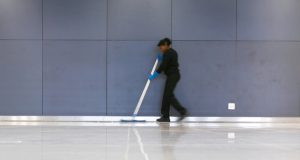 Fred Williams, Service and Repair Manager for ASSA ABLOY Security Doors, explains why correct installation, regular maintenance and certified inspection of fire doors within shared buildings is crucial
Fred Williams, Service and Repair Manager for ASSA ABLOY Security Doors, explains why correct installation, regular maintenance and certified inspection of fire doors within shared buildings is crucial
Fire doors play an effective role in a building’s passive fire protection with more than three million installed in the UK each year.
Current regulations require commercial and social housing developments to be fitted with fire doors. However, at a national level there are no rules for their mandatory inspection and maintenance.
This is an issue for FMs, as fire doors can become unfit for purpose if mistreated or poorly maintained.
PURPOSE AND EFFECTIVENESS
Fire doors are often the first line of defence in a fire and their effectiveness can mean the difference between life and death for building occupants.
There are many vital components of fire doors that distinguish them from conventional doors, ranging from specialised smoke seals around the frame to fire-resistant glazing. Depending on requirements, a fire door can be certified to prevent the spread of fire and smoke from 30 minutes to more than four hours.
However, if just one of these components fails due to poor maintenance or damage, the effectiveness of the door can be severely reduced.
REGULATIONS: MANUFACTURING AND INSTALLATION
In the UK, current guidance states that public or private shared properties should be compartmentalised – spilt into smaller spaces with barriers preventing the spread of fire and smoke. The fire doors used to help create these compartments should be able to halt a fire for at least 30 minutes, with taller or higher occupancy buildings requiring doors that are able to endure for at least 60 minutes.
Validating the performance of a fire door is a legal requirement and currently vetted at project completion, through provision of a current fire test report or independent assessment covering all aspects of the door construction and its features.
Many fire doors, particularly timber doors, are supplied into the market and supported by Global Assessments. This requires the manufacturers of such products to construct the door in accordance with the instructions provided by the door core supplier, who originally tested the assembly. However, the provision of a valid assessment is the only proof of correct construction and this can be provided by the manufacturer themselves.
This has resulted in some fire door manufacturers adopting more stringent controls through an auditable third-party accreditation scheme, such as CERTIFIRE or Q-Mark. This provides additional reassurance that ongoing production of fire products conforms to the original specification.
Currently, there is no regulation governing the installation of the compliant product. If not completed in accordance with the manufacturers’ tested requirements, this may jeopardise the overall performance of the installed product.
As with the production of fire doors, some installers, or manufacturing installers, have adopted auditable third-party accreditation such as FIRAS to cover the installation process.
REGULATIONS: AFTER INSTALLATION
In all property fire inspections, there is a responsibility from the building owner to include checks on the fire doors. However, there is no legal requirement for them to complete any recommended upgrades or repairs, or to prove that they have done so.
This represents a major problem, as doors that do not perform to the required standard could compromise a building’s safety and put occupants at risk. Ultimately, this could lead to liability being assigned to the building owner or facilities manager.
The lack of a mandatory fire door inspection and maintenance scheme also contrasts sharply with the standardised procedures in place for many of the other fire safety systems found in shared properties, including residential.
COMMON FIRE DOOR MAINTENANCE ISSUES
A certified fire door will be a sturdy and reliable piece of equipment. However, poor maintenance, vandalism and even the natural shifting and settling of a building over time can cause them to become ineffective.
If a fire door leaves large gaps around the doorway, is damaged, or jammed open, it completely loses its effectiveness as a fire prevention tool. Some of the most common issues include:
- Gaps – Incorrect ironmongery may result in a sizeable gap underneath or around the fire door. If this is the case, it may not be able to prevent fire or smoke spreading.
- Damaged door closer – Damaged door closers prevent fire doors from shutting properly, meaning it cannot adequately perform its role.
- Damaged seals – If the seal around the door is no longer intact, the door may not be able to contain smoke or fire to the appropriate standard.
- Damage or splits – Any damage sustained by the door could affect its performance. This can be caused by later work, as well as vandalism.
- Wear and tear – Building movement and wear and tear often means a change in the position of doors, leading to open gaps.
PROPPED OPEN DOORS
Propping or wedging fire doors open negates their purpose entirely and is the most common mistake inspectors find when looking over a site. This often occurs because personnel and residents are unaware of a fire door’s primary function and view them in a similar manner to regular doors.
If mandatory inspections come into force, they can help FMs remind building occupants of the importance of keeping fire doors closed at all times.
WHAT NEEDS TO CHANGE
We at ASSA ABLOY Security Doors believe that to ensure a fire door is performing as it should be, twice yearly inspections ought to be mandatory. In addition, an inspector should provide a detailed FIRA report so that subsequent repairs and maintenance are undertaken.
What’s more, we believe that these inspections should be made legal and policed by government to ensure the liability on facilities managers and building owners is reduced.




